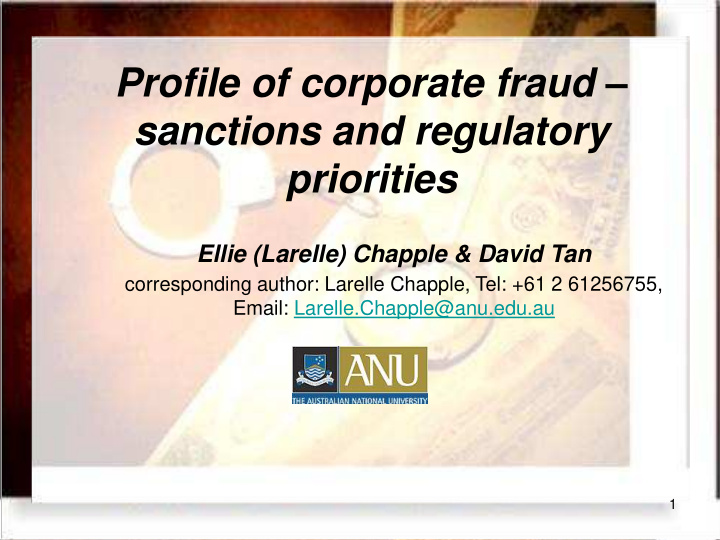



Profile of corporate fraud – sanctions and regulatory priorities Ellie (Larelle) Chapple & David Tan corresponding author: Larelle Chapple, Tel: +61 2 61256755, Email: Larelle.Chapple@anu.edu.au 1
Fraud & corporate governance • Beasley 1996 – link between corporate governance and financial statement fraud • Financial statement fraud- evidence of SEC sanctions, as reported in the Accounting and Auditing Enforcement Releases (AAERs) – We don‟t have access to the same sort of data – We can‟t observe financial statement fraud as „easily‟ – Rather than look at financial statement fraud, examine the types of misconduct sanctioned 2
Purpose of study 1. Identify ASIC enforcement priorities by examining the types of breaches/misconduct enforced 2. Use firm specific characteristics to profile the governance of those sanctioned firms 3
Data sources • Data is hand collected / collated -> subjectivity? • ASIC‟s publicly available statements on enforcement – Media releases – Annual reports • Decided cases • Media attention • Study based on Australian data – BUT would be very feasible to do this in NZ – Access to similar sources – Securities Commission 4
Fraud & misconduct Financial misconduct & fraud Reporting & disclosure Misappropriation & abuse Financial statement fraud Audit breaches Fundraising and prospectus Misappropriation Misleading & deceptive Insider trading/ disclosure market manipulation Directors duties breaches (inc insol trading) Financial services breaches 5
2 types of fraud/misconduct • 236 observations 2004 2005 2006 2007 2008 Misappropriati 25 43 23 15 21 on & Abuse Reporting & 18 34 29 18 10 Disclosure Total 43 77 52 33 31 6
2 types of fraud/misconduct 90 80 70 ASIC Fraud Cases 60 50 Misappropriation & Abuse 40 Reporting & Disclosure 30 Total 20 10 0 2004 2005 2006 2007 2008 7
Overall • 43% reporting & disclosure • 57% abuse and misappropriation • 81% in the financial sector 8
8 sub categories 2004 2005 2006 2007 2008 Total Financial Statement 6 12 3 5 2 28 Fundraising/Prospectus 1 4 4 3 0 12 Misleading/Deceptive 11 18 21 10 8 68 Auditor Related 3 3 1 0 0 7 Misappropriation/Financial 6 12 3 4 3 28 Insider Trading/Market Manipulation 1 3 1 2 0 7 Director Duties/Insolvent Trading 5 11 10 2 8 36 Financial Services Breaches 10 14 9 7 10 50 Total 43 77 52 33 31 236 9
ASIC priorities • 2003 – “fighting fraud & misconduct” – Chair - David Knott • 2004 – new Chair – Jeff Lucy – reiterates fighting fraud & misconduct – fight insolvent trading, – improve poor disclosure in capital raisings • 2005 – “patrolling a broad territory” – Poor disclosure (bad news) – compliance 10
ASIC priorities • 2006 – Conflicts of interests in the financial services sector & superannuation disclosures • 2007 – new Chair – Tony D‟Aloisio – Review of ASIC‟s activities – Continuous disclosure/market manipulation/insider trading • 2008 – “a year of change” – Capital market integrity – GFC & disclosure 11
Fraud cases Information collected concerning each fraud case includes: • Whether firm was listed at the time of the ASIC investigation • Whether more than one person was involved in the alleged fraud • Whether the CEO was involved in the alleged fraud • Whether any directors were involved in the alleged fraud • Whether any top firm executives were involved in the alleged fraud 12
What we found… Fraud Case Characteristic Percentage of Fraud Cases More than 1 person involved 74.55% CEO was involved 70.54% At least one director involved 71.56% AT least one top executive 70.48% involved 13
perpetrators • It is clear that when more than one person is involved in a fraud case, it is highly likely that the CEO, directors, and top executives are also involved. • “Tone at the top” CEO Director Top Executive More than 1 CEO 1 Director 0.89*** 1 Top Executive 0.89*** 0.77*** 1 More than 1 0.89*** 0.76*** 0.81*** 1 14
Governance characteristics • Economic Sector (2-digit GICS code) • Whether firm is listed on the ASX • Number of directors on the board • Whether there is a duality in the role of the CEO and chairperson of the board • The proportion of non-executive directors on the board • Whether an audit committee is present • Whether a nomination committee is present • Whether a remuneration committee is present • Whether the firm complied with all the non-compulsory ASX Corporate Governance Principles 15
Profile Corporate Governance Characteristic Sample Average Board Size (No. Directors) 6.79 Duality of the Role of CEO & 0.25 Chairperson Proportion of Non-Executive Directors on 0.70 the Board Presence of an Audit Committee 0.79 Presence of a Remuneration Committee 0.54 Presence of a Nomination Committee 0.36 Comply with ASX Corporate 0.14 Governance Principles 16
Profile Overwhelmingly the sanctioned firms were different in governance profile to the standard population of listed Australian firms in a couple of respects: 1. The duality of the chair CEO is observed in 25% of cases – usually this is expected to be in 3% of the entire population of listed firms. 2. The presence of an audit committee is negatively correlated with top management perpetrators, indicating a positive signal for the monitoring role of the audit committee. 3. The compliance rate of 14.3% of sanctioned firms - The ASX monitors compliance every year and reports on compliance – typically the ASX finds compliance to be in the vicinity of 90%. 17
What next • The “profile” is correlation – not causation • With more listed firms in the sample (n=29) could try more causation research techniques • Speculative: ASIC targets weak governance – top level perpetrators, tone at the top message • NZ message? 18
Recommend
More recommend